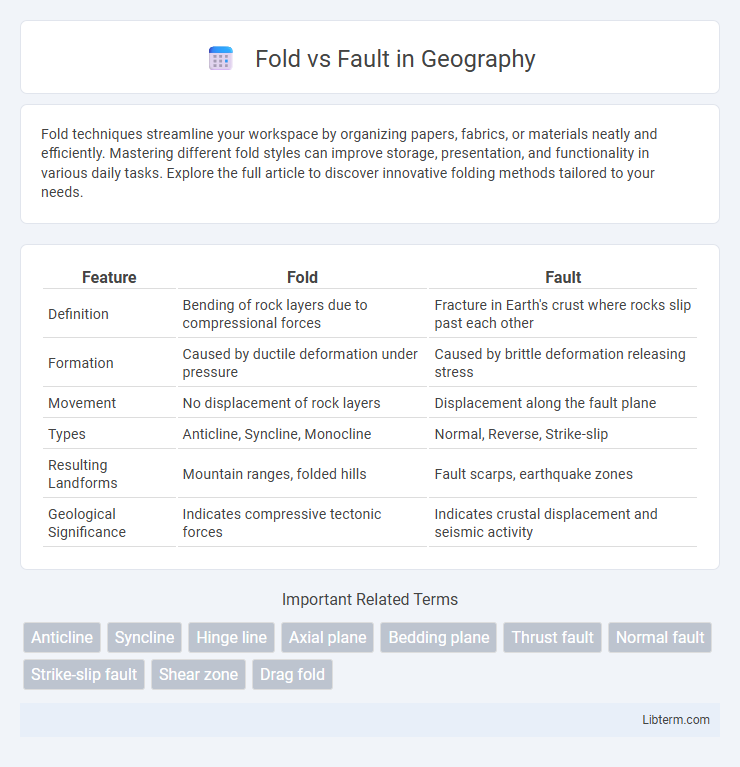Fold techniques streamline your workspace by organizing papers, fabrics, or materials neatly and efficiently. Mastering different fold styles can improve storage, presentation, and functionality in various daily tasks. Explore the full article to discover innovative folding methods tailored to your needs.
Table of Comparison
| Feature | Fold | Fault |
|---|---|---|
| Definition | Bending of rock layers due to compressional forces | Fracture in Earth's crust where rocks slip past each other |
| Formation | Caused by ductile deformation under pressure | Caused by brittle deformation releasing stress |
| Movement | No displacement of rock layers | Displacement along the fault plane |
| Types | Anticline, Syncline, Monocline | Normal, Reverse, Strike-slip |
| Resulting Landforms | Mountain ranges, folded hills | Fault scarps, earthquake zones |
| Geological Significance | Indicates compressive tectonic forces | Indicates crustal displacement and seismic activity |
Introduction to Folds and Faults
Folds and faults are fundamental geological structures formed by the deformation of the Earth's crust due to tectonic forces. Folds occur when rock layers bend without breaking, resulting in features like anticlines and synclines, while faults are fractures along which there has been significant displacement of rock masses. Understanding the characteristics and formation processes of folds and faults is essential for interpreting Earth's structural geology and assessing seismic activity.
Definition of Fold
A fold is a bend or curve in rock layers caused by compressional forces that deform the Earth's crust without breaking it. Unlike faults, which involve fractures and displacement, folds maintain the continuity of rock strata while changing their orientation. Common types of folds include anticlines and synclines, which are key indicators of tectonic stress and geological history.
Definition of Fault
A fault is a fracture or zone of fractures between two blocks of rock, where significant displacement has occurred due to tectonic forces. Faults often result in earthquakes as the accumulated stress is released along the fracture. Unlike folds, which bend rock layers without breaking them, faults represent a break and movement in the Earth's crust.
Key Differences Between Folds and Faults
Folds are bends in rock layers caused by compressional forces that create anticlines and synclines, whereas faults are fractures along which rocks have slid past each other due to tectonic stress. Folds deform rocks without breaking them, maintaining rock continuity, while faults involve displacement and breakage of rock strata. The key difference lies in deformation style: folds result from ductile deformation, and faults result from brittle failure.
Causes of Folding and Faulting
Folding occurs primarily due to compressional stress that deforms rock layers by bending them without breaking, often in regions of plate convergence where tectonic plates collide. Faulting results from brittle failure when stress exceeds the rock strength, causing fractures and displacement along the fault plane, commonly linked to tensional, compressional, or shear forces. Both processes are driven by tectonic forces but differ in the rock's response: ductile deformation for folding and brittle rupture for faulting.
Types of Folds
Types of folds include anticlines, synclines, monoclines, and recumbent folds, each representing different bending patterns in layered rock strata caused by compressional forces. Anticlines are arch-shaped folds with older rocks at the core, while synclines are trough-like folds containing younger rocks centrally. Monoclines form step-like bends, and recumbent folds exhibit horizontal or overturned limbs, distinguishing them from faults, which are fractures where rock displacement occurs.
Types of Faults
Faults are fractures in Earth's crust along which displacement has occurred, categorized primarily into normal, reverse, and strike-slip faults based on the relative movement of rock masses. Normal faults result from extensional forces causing the hanging wall to move downward relative to the footwall. Reverse faults, driven by compressional forces, show the hanging wall moving upward, while strike-slip faults involve horizontal displacement due to shear stress, with lateral movement along the fault plane.
Geological Significance of Folds and Faults
Folds and faults play critical roles in understanding Earth's structural geology by revealing deformation patterns within the crust caused by tectonic forces. Folds indicate ductile deformation where rock layers bend without breaking, providing insights into stress directions, rock properties, and metamorphic conditions, while faults represent brittle failure with fractures and displacement, essential for assessing seismic hazards and crustal movements. Together, these structures help geologists reconstruct tectonic histories, locate natural resources, and predict geological hazards with precision.
Methods of Identifying Folds and Faults
Geologists identify folds through field mapping, using geophysical techniques like seismic reflection to detect bent rock layers, and by analyzing structural features such as anticlines and synclines. Faults are recognized by observing displacement in rock strata, using seismic tomography to image fault planes, and detecting fault scarps or slickensides in outcrops. Remote sensing methods, including satellite imagery and LiDAR, also assist in distinguishing folds from faults by revealing surface deformations and lineaments.
Folds vs Faults: Practical Examples in Geology
Folds form when rock layers bend due to compressional forces, creating structures like anticlines and synclines commonly observed in mountainous regions. Faults occur when rocks fracture and displace along a fracture plane, producing features such as normal, reverse, and strike-slip faults found in earthquake zones. Understanding folds and faults is crucial for geologists in analyzing seismic activity, resource reservoirs, and landscape evolution.
Fold Infographic

 libterm.com
libterm.com